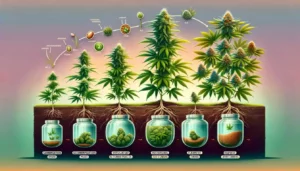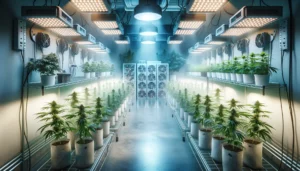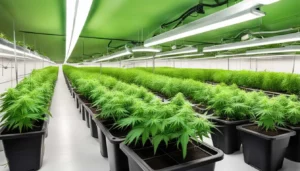This guide provides a comprehensive comparison between hydroponics and soil-based systems for indoor cannabis growing. It aims to equip the reader with knowledge about these two common methods, enabling them to make informed decisions based on their specific needs and circumstances. Key factors such as setup cost, maintenance, growth rate, and quality of yield are discussed in detail.
Understanding Indoor Cannabis Grow Systems: What Are They?
Indoor cannabis grow systems refer to the methods and setups used to cultivate cannabis plants indoors, away from the natural outdoor environment. These systems are designed to provide a controlled environment that allows growers to manipulate various factors such as light, temperature, humidity, and nutrients to optimize plant growth and maximize yields.
In these setups, cannabis plants are grown in a confined space such as a grow tent, grow room, or even a specially designed indoor greenhouse. The primary goal of these systems is to mimic or even surpass the ideal conditions that plants would experience in their natural outdoor environment.
Indoor cannabis grow systems can be broadly categorized into two main types: hydroponics and soil-based setups. Hydroponics involves growing plants without the use of soil, where the roots are suspended in a nutrient-rich water solution. On the other hand, soil-based setups rely on traditional soil as the growing medium, providing plants with necessary nutrients and moisture.
These systems offer several advantages over outdoor cultivation, including greater control over environmental factors, protection from pests and diseases, and the ability to grow year-round regardless of seasonal limitations. Additionally, indoor grow systems allow for the cultivation of cannabis strains that may not thrive in the local climate or are not suited for outdoor cultivation due to legal restrictions.

An illustration showing a basic indoor cannabis grow setup.
Breaking Down Hydroponics: How Does It Work?
Hydroponics is a method of growing plants that eliminates the need for soil. Instead, plants are grown in a nutrient-rich water solution that provides them with all the essential elements they need to thrive. This water solution is typically circulated through the roots of the plants, allowing them to absorb the nutrients directly.
One of the key components of a hydroponic system is the growing medium. This medium is used to support the plants and provide stability for their root systems. Commonly used growing mediums in hydroponics include perlite, vermiculite, coconut coir, and rockwool. These mediums provide aeration and drainage for the roots while also retaining moisture.
In a hydroponic setup, the water solution is carefully balanced with the necessary nutrients required for plant growth. This precise control over nutrient levels allows growers to fine-tune the plant’s diet and optimize their growth. Nutrient solutions are typically mixed with water and delivered to the plants through a system of tubes or channels. This system can be automated, ensuring that the plants receive a consistent supply of nutrients at the appropriate times.
Hydroponics also offers the advantage of better water efficiency compared to traditional soil-based growing methods. The water used in the system is recirculated and reused, reducing waste and conserving resources. Additionally, the absence of soil eliminates the risk of soil-borne diseases and pests, resulting in healthier plants.
To ensure successful hydroponic cultivation, growers must closely monitor and maintain the pH and nutrient levels of the water solution. Regular testing and adjustments are necessary to prevent nutrient deficiencies or toxicities. Adequate lighting is also crucial in hydroponics, as plants rely solely on artificial light sources for photosynthesis.
Can Hydroponics Increase the Quality and Quantity of Your Yield?
Hydroponics has gained popularity in the cannabis cultivation industry due to its potential to increase both the quality and quantity of yields. By providing plants with optimal nutrient levels and a controlled environment, hydroponic systems can maximize the potential of cannabis plants.
One of the key advantages of hydroponics is the ability to fine-tune nutrient delivery. In traditional soil-based setups, plants may not have access to all the necessary nutrients in the soil, leading to nutrient deficiencies or imbalances. However, in hydroponics, growers have precise control over the nutrient solution, ensuring that plants receive all the essential elements they need for healthy growth. This can result in improved plant vigor, increased cannabinoid and terpene production, and ultimately, higher-quality cannabis.
In addition to nutrient control, hydroponics allows for optimized environmental conditions. Growers can adjust factors such as temperature, humidity, and CO2 levels to create an ideal climate for cannabis plants. This controlled environment promotes faster growth and can lead to larger yields.
Another way hydroponics can enhance yield is through faster growth rates. With a well-designed hydroponic system, plants can receive nutrients more efficiently and have constant access to water and oxygen. This leads to accelerated vegetative and flowering stages, allowing for more harvest cycles per year. The increased number of harvests can significantly boost overall yield.
Moreover, hydroponics can also help mitigate the risk of pests and diseases. By eliminating soil, growers reduce the chances of soil-borne pathogens and pests affecting their plants. This reduces the need for pesticides and allows for cleaner, healthier cannabis.
While hydroponics offers numerous benefits, it does require a higher initial investment compared to soil-based setups. The cost of equipment, nutrient solutions, and electricity for lighting and pumps should be considered when evaluating the financial feasibility of hydroponics.
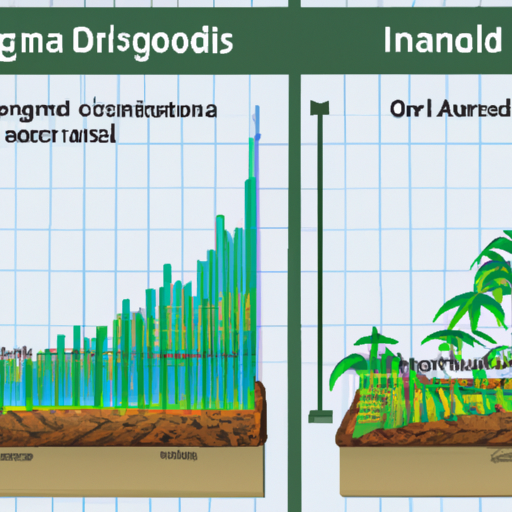
Graph comparing the yield of hydroponic and soil-based cannabis grows.
Soil-Based Setups: Are They the Traditional and Best Way?
Soil-based setups have long been the traditional method of growing cannabis, and many growers still swear by their effectiveness. Soil provides a natural and familiar medium for plants to grow in, allowing for a more organic approach to cultivation.
One of the primary advantages of soil-based setups is the complexity and diversity of microorganisms present in the soil. These microorganisms form a symbiotic relationship with the plant roots, aiding in nutrient uptake and protecting against pathogens. This natural ecosystem in the soil can contribute to improved plant health and resilience.
Another benefit of soil-based setups is the forgiveness they offer to less experienced growers. Soil acts as a buffer, holding onto nutrients and moisture, which can be beneficial for novice cultivators who may struggle to maintain precise nutrient levels in hydroponic systems. The forgiving nature of soil-based setups allows for some margin of error and provides a learning curve for growers to develop their skills.
Furthermore, soil-based setups are generally more cost-effective compared to hydroponics. The initial investment for soil-based systems is typically lower, as it does not require extensive equipment like pumps, reservoirs, or nutrient solutions. Additionally, soil can be reused for multiple growing cycles with proper care and amendment, further reducing costs in the long run.
However, soil-based setups do have some limitations. The quality of the soil plays a significant role in the success of the cultivation. It is crucial to choose a high-quality soil blend or amend the soil with organic matter to ensure the right balance of nutrients for the plants. Soil-based setups also require more frequent watering and may have a longer growth cycle compared to hydroponics.
“The best fertilizer is the gardener’s shadow.” – Understanding the Maintenance Effort for Hydroponic and Soil-Based Systems
Maintaining a successful indoor cannabis grow system requires dedication and consistent effort, regardless of whether you choose hydroponics or soil-based setups. However, the specific maintenance requirements differ between these two systems.
- 1. Nutrient Management:
Hydroponics systems require careful monitoring and adjustment of nutrient solutions. The grower needs to regularly test the pH and nutrient levels in the reservoir and make necessary adjustments to ensure optimal plant health. This process can be time-consuming and requires attention to detail. In contrast, soil-based setups rely on the natural nutrient content of the soil, but periodic soil testing is still recommended to ensure proper nutrient balance. - 2. Watering and Irrigation:
Hydroponic systems typically use automated irrigation systems, such as drip or flood and drain systems, to deliver water and nutrients to the plants. These systems require regular monitoring and adjustment to ensure the plants receive the right amount of water. On the other hand, soil-based setups typically require manual watering, which allows the grower to have more control over the moisture levels and tailor the watering schedule to the specific needs of the plants. - 3. Pest and Disease Management:
Both hydroponic and soil-based setups can be susceptible to pests and diseases. In hydroponics, the absence of soil does not eliminate the risk of pests and diseases, as they can still be introduced through contaminated water or equipment. Growers must implement regular inspections and preventive measures such as using beneficial insects or organic pest control methods. Similarly, soil-based setups require diligent monitoring for pests and diseases and may require the use of organic pesticides or fungicides.Regardless of the system chosen, regular plant maintenance tasks such as pruning, training, and removing dead leaves or plants are essential for promoting healthy growth and maximizing yields. Additionally, maintaining proper temperature, humidity, and ventilation levels in the grow space is crucial for both hydroponics and soil-based setups.
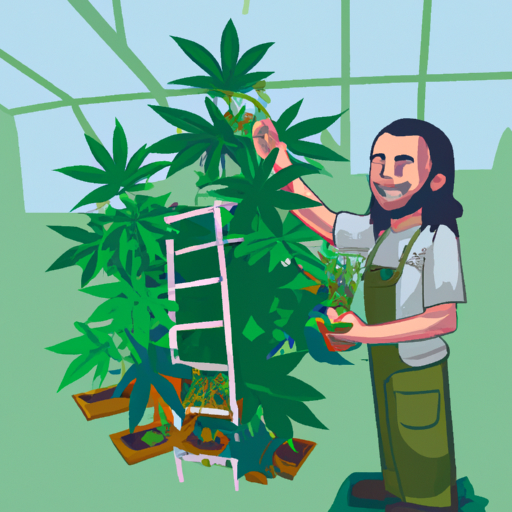
Illustration of a gardener tending to both hydroponic and soil-based cannabis plants.
Weighing the Costs: Hydroponics vs. Soil Cannabis
When considering indoor cannabis grow systems, it is important to weigh the costs associated with hydroponics and soil-based setups. While both methods have their advantages and disadvantages, the financial aspect is a significant factor to consider. Here, we will delve into three key areas of cost comparison:
initial investment, ongoing expenses, and long-term sustainability.
- 1. Initial investment:
Hydroponics systems generally require a higher initial investment compared to soil-based setups. This is primarily due to the need for specialized equipment such as grow lights, reservoirs, pumps, and nutrient solutions. Additionally, hydroponic systems often require a controlled environment, which may involve purchasing ventilation systems, air conditioning units, and environmental controllers. On the other hand, soil-based setups require less specialized equipment, with the main investment being high-quality soil and containers. - 2. Ongoing Expenses:
In terms of ongoing expenses, hydroponics systems tend to have higher costs. Nutrient solutions for hydroponics can be expensive and need to be replenished regularly. Additionally, energy costs may be higher due to the need for continuous operation of grow lights and equipment. In contrast, soil-based setups require less frequent nutrient supplementation and may have lower energy costs as natural sunlight can be utilized, reducing the need for grow lights. - 3. Long-Term Sustainability:
When considering long-term sustainability, hydroponics systems may offer advantages. Due to their controlled environment, hydroponics can potentially lead to higher yields and faster growth rates, allowing for more frequent harvests. This increased productivity can offset some of the initial and ongoing costs. Soil-based systems, however, rely on the natural nutrient content of the soil, which may require occasional soil amendments and may not provide the same level of control over plant growth.
Making the Choice: Which System is Right for You?
When it comes to choosing the right indoor cannabis grow system, there are several factors to consider. Each method, hydroponics, and soil-based setup has its own unique benefits and drawbacks. It ultimately boils down to your personal preferences, resources, and goals as a grower.
If you prioritize control over every aspect of the plant’s environment and want to maximize yields and growth speed, hydroponics may be the better choice for you. With hydroponics, you have the ability to fine-tune nutrient levels, pH, and other environmental factors to optimize plant growth. Additionally, hydroponic systems can be more space-efficient, making them ideal for growers with limited space.
On the other hand, if you prefer a more natural and traditional approach and have a limited budget, soil-based setups may be the way to go. Soil provides a raw buffer for nutrients and helps develop a complex microbial ecosystem, which can promote overall plant health. Soil-based systems also tend to require less maintenance and can be more forgiving for novice growers.
Consider the resources available to you. Hydroponic systems require a significant upfront investment in equipment and ongoing costs for nutrient solutions and electricity. Soil-based setups, on the other hand, may require less initial investment and ongoing costs.
Furthermore, think about your goals as a grower. Are you looking to produce a large quantity of cannabis or prioritize the quality of your yield? Hydroponics may offer higher yields, but soil-based setups can produce cannabis with a more natural and robust flavor profile.

Image of a gardener thoughtfully contemplating two different indoor grow setups.
Indoor Cannabis Grow Systems:
| System Type | Setup Cost | Maintenance | Growth Rate |
|---|---|---|---|
| Hydroponics | Moderate | High | Fast |
| Soil-Based | Low | Low | Moderate |
In conclusion, both hydroponic and soil-based indoor cannabis grow systems have their advantages and drawbacks. The choice largely depends on the grower’s expertise, time, budget, and personal preferences. While hydroponics may lead to faster growth and higher yields, soil-based systems are often more natural and forgiving. It is essential to understand the nuances of each method to determine the one that best suits your indoor cannabis cultivation goals.

